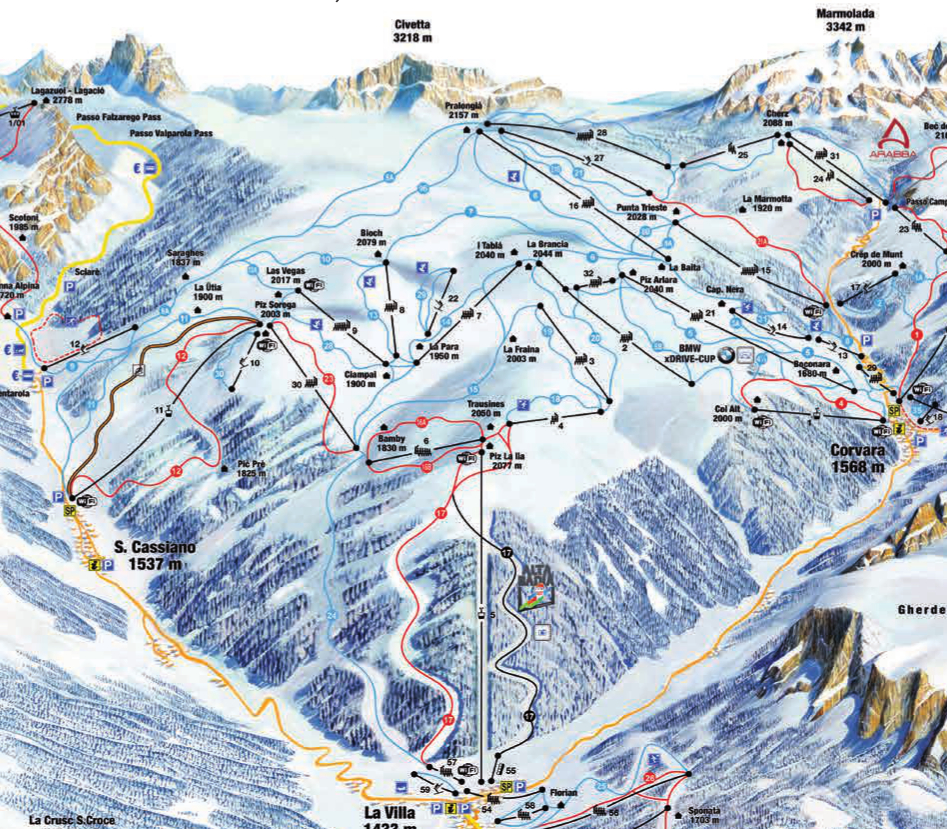Piste skiing in Alta Badia
Alta Badia is a region of resorts, consisting of Corvara, Colfosco, La Villa, San Cassiano, Armentarola and Pedratches. They are world renowned for their superb family friendly skiing and this is absolutely justified. Stretching from Passo Campolongo in the South, Passo Gardena in the West, Val Badia in the North and Passo Valparola in the East, this area is really extensive with a huge variety of pistes and difficulties.
The down side is it is inevitably busy, more expensive than other areas (especially in restaurants) and can be confusing to navigate around, especially the main area to the east of Corvara where the terrain is quite rolling. That said, if you know your way around there are some really excellent hidden areas which are lesser known where you can escape the crowds.
Access
Alta Badia can be reached:
- from the south by driving from Alleghe via Passo Campolongo in 45 minutes. This is preferable if arriving from Italy as Passo Campolongo is usually open. Chains/Snow Tyres are essential as there is frequently snow on the road after a snow fall. However it does get cleared quickly.
- from the north by Val Pusteria. This is also the most snow safe route to arrive from Austria.
- From the west by Passo Gardena. This is one of the most likely passes to close as there is a long avalanche prone section. If travelling from the west, check whether it is open before departing.
- From the East via Passo Falzarego and Passo Valparola.
The Eastern area
I’ll start with the main area as this will for many people be the main attraction. Served directly by Corvara, La Villa, San Cassiano and Armentarola, it is the best area for beginners and kids I think I have skied anywhere. Here, the Blue run is king, with most being wide and easy angled with little to take you by surprise. Towards La villa there is a harder area with many excellent reds and also the Gran Risa, an FIS race course, but more about those later.
The area is as previously stated, quite rolling and lower in altitude with minor wooded peaks as opposed to the surrounding taller Dolomite peaks. There are a great number of long cruisey valley runs, but not like the single track ones you find in France – wide, fast pistes which are as fun for more advanced skiers as for the beginner. It’s the perfect place to progress your skiing, to gfet really comfortable with blues so that you feel prepared for reds, or to practice carving.
The main peaks are from South to North, Monte Cherz, Pralongia, Biok, Piz Sorega and Piz La Ila.
Monte Cherz is you gateway to the area from the south and Arabba. By descending to Passo Camplolongo you can reach the Cherz 1 lift which whisks you to the summit in a single ride. This bald peak has two runs which return to Passo Campolongo, a sweeping red and a blue, imaginatively called Campolongo Sinistra and Destra. The red, Destra is a fast fun piste and an excellent return run to Campolongo at the end of the day.
Moving away from Cherz, you follow a easy but fantastically fun blue La Vizza #32 towards Rifugio La Viza. Hop off the lift and go straight ahead! It runs down through forests and has beautiful carving turns all the way down.
The lift in front of you, Masarei takes you to the next peak, Pralongia. Take a right turn down Del Sole #34 for a fast carving blue or left down Incisa #33 which turns back on itself by a hut for a very gentle way down. At this left turn, if you continue straight you will find a narrow and steep red La Marmotta #21a to Planac which can get a little icy – better for a more advanced skier. Or continue forwards off Masarei and you’ll find twin runs, #9a and #9b which lead to La Villa on the other side of the massif. These are both very easy runs but not ideal for snowboarders who might struggle to keep speed on the shallow entry runs. That said it is a quick way for those coming from the south to reach the pistes around La Villa or to get to Passo Falzarego as there are taxi buses which allow access from Armentarola. For this, make sure you follow the short link run on the right which is easy to miss.
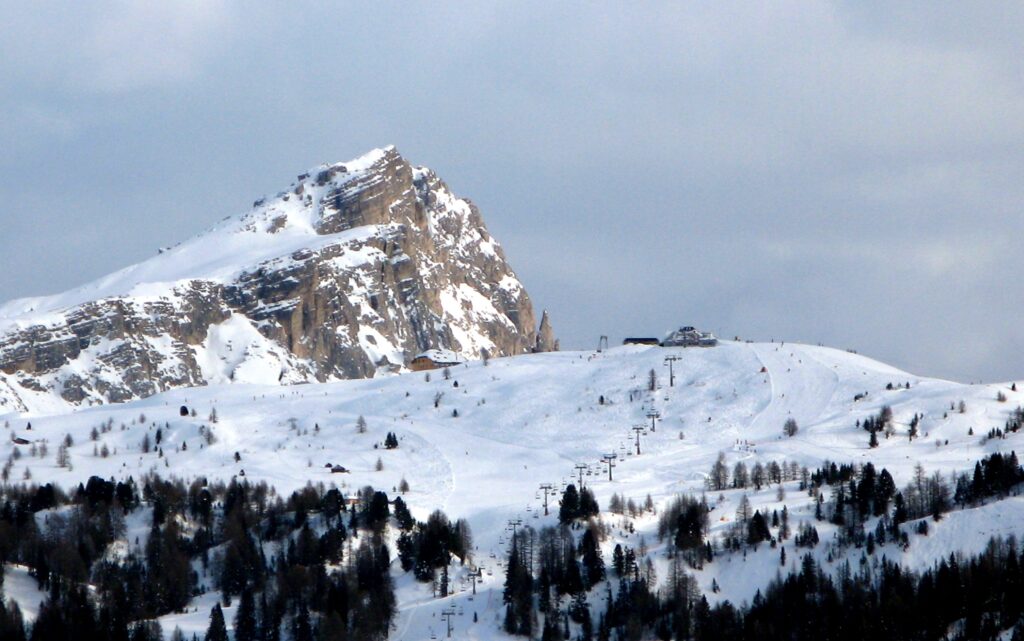
Lastly from Pralongia there are two runs down and left of the Masarei lift, both much the same, steady blue runs. The left hand run #21b drops to the Rifugio Punta Trieste where the track splits – head left and you will return towards Masarei. Otherwise #8a and #8b both head to the same point as #8 (which is the right hand piste mentioned before) to the bottom of the Pralongia 2 chairlift.
From here you can continue to Corvara by continuing down #8 with various variations to allow you to get to other places. The piste starts directly behind the Pralongia 2 lift house and is often obscured by crowds of people – take care to slow down as it’s usually chaos at this junction! Right beneath the lift house the piste is also quite steep and can get quite bumpy through the day so take care – often the best snow is on the very far left margins of the piste. Once past this it returns to being a wide carving piste. The first variation is a left turn to the Pralongia 1 chair lift and Planac – the bottom is a bit of a pain here as there is a long flat section – not ideal for boarders or beginners. If you manage to maintain speed from the left turn you can get to the magic carpet into the lift house, tumble and its a lonely walk!
Otherwise continue easily down past various old ski tows and you will come to an obvious split which is netted to force you to slow down. It’s a critical junction and you can easily split a party here! The right hand one takes you to the east side of Corvara, back towards Col Alt and the eastern area, i.e. Piz La Ila, Biok and Piz Sorega. Go right and you end up in the Western area and on your way to Passo Gardena. If you do take the wrong turn down to the Boe and Borest lifts it is easy to rectify as there is a chair which returns you to the junction.
Col Alt accesses a mass of blues especially when combined with the Braia Fraida lift – I won’t detail these as they are just fun to explore. There’s a mix of valley runs and shorter linking runs all perfect for kids and beginners. Braia Fraida is a curious lift in that it has a mid station drop off which allows you to return to Corvara.
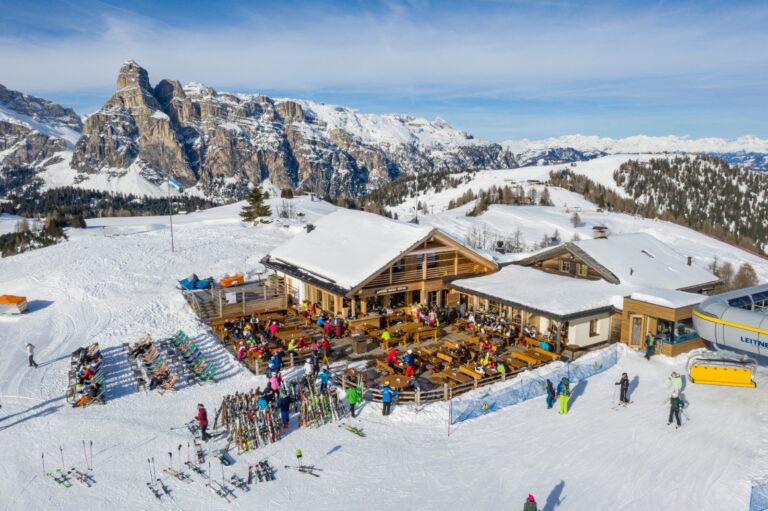
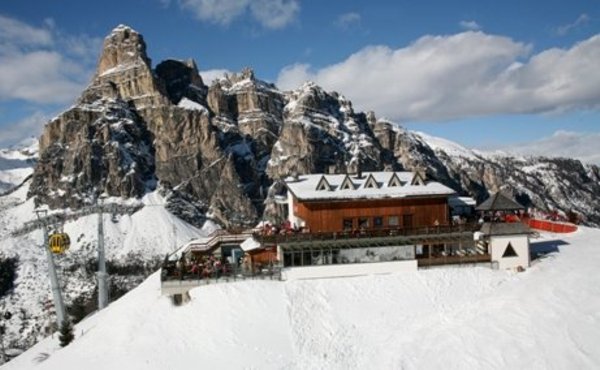
Stay on for a few metres and you arrive at Rifugio La Brancia which is another quite critical point as the three pistes lead in three completely different directions. Take #6(blue) La Brancia Pralongia 2 to return southwards to Pralongia 2 and from there to Corvara or back towards Monte Cherz. Take #20(blue) Roby beneath the lift and takes you directly to the Gran Risa (black) or Altin (red) both of which swiftly descend to La Villa, or ski straight ahead off the lift on piste #14(blue) La Para to reach the Biok/Piz Sorega bowl. This area is really worthwhile exploring, although the runs are short there are some superb things to do here, including 3 skier/boarder cross runs which start from Rifugio Biok. I can also recommend Rifugio Biok for food. It has outstanding views and the food is very very good, although as little more pricey than normal. They do a fantastic variety of local dishes with the lightest Knoedel (dumplings) and venison stews. It’s ideal if you have kids as you can send them off to do some laps on the skier cross whilst you drink in the view and order food!
From this bowl you can descend to the north to #23(red) Fraina – this piste can take you all the way to La Villa by joining a blue called Bamby or you can use a lift to reach Piz la Ila, from where one of the greatest pistes of the Dolomites starts, the Gran Risa. If steep, twisting, sustained black is your bag, this is right up there with the best in the world. Winding down through the trees the piste just keeps going and it is so steep that it’s hard to imagine anyone racing down it. In my view, if you are up to the job, this is a piste to not miss and is a test of any skiers technical ability. Indeed one section is called “Il Muro”, literally “the wall”! The other runs from Piz La Ila are equally good, although substantially easier. #17 Altin is a wide red whilst #16a returns you to La Fraina by a steep wide red.
And now we come to the final area, Piz Sorega. From La Fraina you can reach the summit of Sorega, or indeed from San Cassiano. There are blue pistes which easily link onto #9 from Pralongia so you can get to Armentarola from here. Or the rather nice #12a Piz Sorega A red run down is a great easy red. And of course you can return to the Biok bowl with all its fun!
The Western Area
The Western area is actually two independent areas. The first, south of Corvara and west of the road to Campolongo. It nestles beneath Piz Boe and has mostly reds and revolves around the Crep de Munt. The other extends from Colfosco to Passo Gardena and is linked to Corvara with a horizontal linking lift called Borest. This area is picturesque due to the huge rock walls of the Sella, Sasshonger, Civazes and the Gran Cir, although it can be quite cold as some of the runs are permanently in the shade of the Sella Massif.
Crep de Munt and Piz da Lech
To the south this area links to the Arabba ski area by Passo Campolongo; to the north it ends at the Borest and Boe lifts. At the northern end you can continue to Col Alt and Colfosco. The area in general is busy as it is one of the main thorough fares for the Sellaronda in both directions. there are certain bottlenecks which can prove quite unpleasant due to this traffic, and as such I would not particularly recommend it unless its very quiet, you are passing through anyway, or have just run out of things to do. That said there are some nice runs, so I will detail these in particular rather than
The descents from Bec de Roces at the southern most end are both fun, the blue in particular which can get quite bumpy due to it’s narrow dimensions. This makes it a good place to learn bump skiing technique; it’s neither long nor desperately steep so can easily be lapped.
There is a black, #1 Vallon which changes into a red lower down named Boe – the lower section of this is the standard run down to Corvara and is a lovely run, quite open and wide, and although it gets busy at the bottom, it’s still fun. The black section is reached by a chairlift from the top of the Boe lift from Corvara and is a reasonable proposition for people starting out on blacks as it’s never very steep.
Finally a word of warning about returning southwards. #22 which descends from the Boe cablecar station is absolutely regularly a horror show. After the first runs, it soon gets carved up into large moguls, due to the direct sunlight softening the snow and the narrowness of the run and is littered with skiers who have ever seen a bump field before and are quite understandably in distress! There is an easy way to avoid this, by descending #1 Boe in seemingly the wrong direction. At the bottom of the first pitch, keep right where there is a small linking run which returns you towards the Passo Campolongo via a much less skied run, #22 Costaratta. After having taken beginners the former way many times, I can say with absolute confidence that it’s one of the most unpleasant experiences in the whole Dolomites ski carousel!
Colfosco and Passo Gardena
The area to the west of Corvara is actually not connected by piste as the last section of the valley coming into Corvara is quite flat. At connecting lift called Borest has therefore been built which can be ridden in either direction for around 2.5km to reach Colfosco. The village itself has quite a number of ski in-ski out apartments and hotels and also a good selection of easy pistes. Directly in the vicinity of the Borest station, there are some really easy blue runs, ideal for beginners and served by a chairlift, a ski tow and a bubble car; the latter is the most interesting and transports you northwards towards the foot of Sasshonger and Civazes. This sunlit bowl is a hidden gem, with some really extraordinary views of the Sella group aswell as some quiet runs. Upon arrival you now have the choice to go up to your left by a chairlift to the excellent #50 Forcelles – to reach this you must ski straight out of the lift house and down to the right, hugging a small island of trees. The hut near the summit of the Forcelles lift is a fantastic spot for some lunch as you can survey the enormous north facing wall of the Sella group, complete with icefalls and the magnificent Val Mezdi.
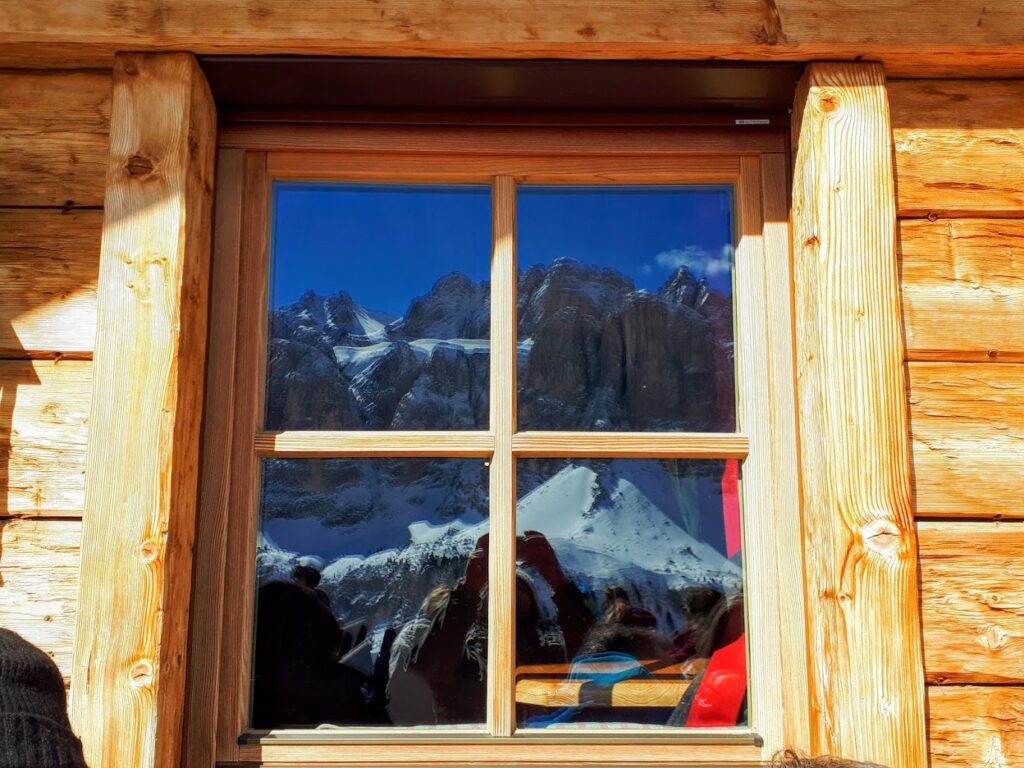
Or ski 100m further to the Col Pradat lift which takes you towards Sasshonger, again with fabulous views and a hut. The desenct from here is either a blue or the short but steep black #45 Col Pradat.
Returning to the Borest base station, you can now move towards Passo Gardena by taking first a 2 man chairlift from below Borest, then a long bubble lift which has a mid station; get out here for blue runs back to Borest, all very suitable for beginners. Or continue to the top just below the Gran Cir to a large selection of red runs. Here you will find the Jimmihutte which is again in a fantastic position.
The descent directly from here is a great open carving red run, #40 Frara which leads into #41 back to Colfosco or the mid station of the bubble car.
Or take a traversing line to other lifts and explore these upper slopes of Passo Gardena, particularly make sure you visit the top of the Frea lift where there are absolutely brethtaking views of Sassolungo and Val Gardena, Alpi di Siusi and the Sella Pass. The long run back to the valley is quite easy for a red, I’d say I have skied quite a number of harder blues. It’s a bit pedestrian, but you’re skiing it for the location which is really quite mind-bending under the massive walls of the Sella!
The Northern Area
This is a minor area by comparison to the others but never the less worthwhile, especially because it is off the beaten track and provides an interesting extension in an overlooked area. Indeed it is “marketed” as the La Crusc Skitour. It starts at La Villa and can be easily completed in 2-3 hours and takes in some beautiful pistes at the low end of the difficulty scale. It easy to join the tour from thee Gran Risa or any other piste arriving from Piz La Ila with a connecting chairlift which departs from the back of the Piz La Ila gondola car park.
The start is a little disjointed with two short lifts and subsequent runs from the carpark to reach the Gardenaccia lift. In minutes you’ll reach the Utia Sponata, a hut on your left as you descend the red #26. This is a nice spot for lunch, reasonable food, a good view and very convenient. You continue #26 Sponata (red) for a long and fun descent which twists and winds its way down the mountain with some comfortable high speed carving turns. As you pull into the lifts at the bottom, make sure you go to the right hand lifthouse which is just after a bridge. Praduc is a horizontal lift link which carries you 1km down the valley to the outlying La Crusc ski area. You join a 6 person chair, then a large bubble car (complete with heated seats!) to reach the top of the area, beneath the huge wall of the Heiligkreuzkofel/Sas de la Crusc. If you have a few minutes its worth walking up to the hamlet just above the top station where there is a picturesque church and hut.
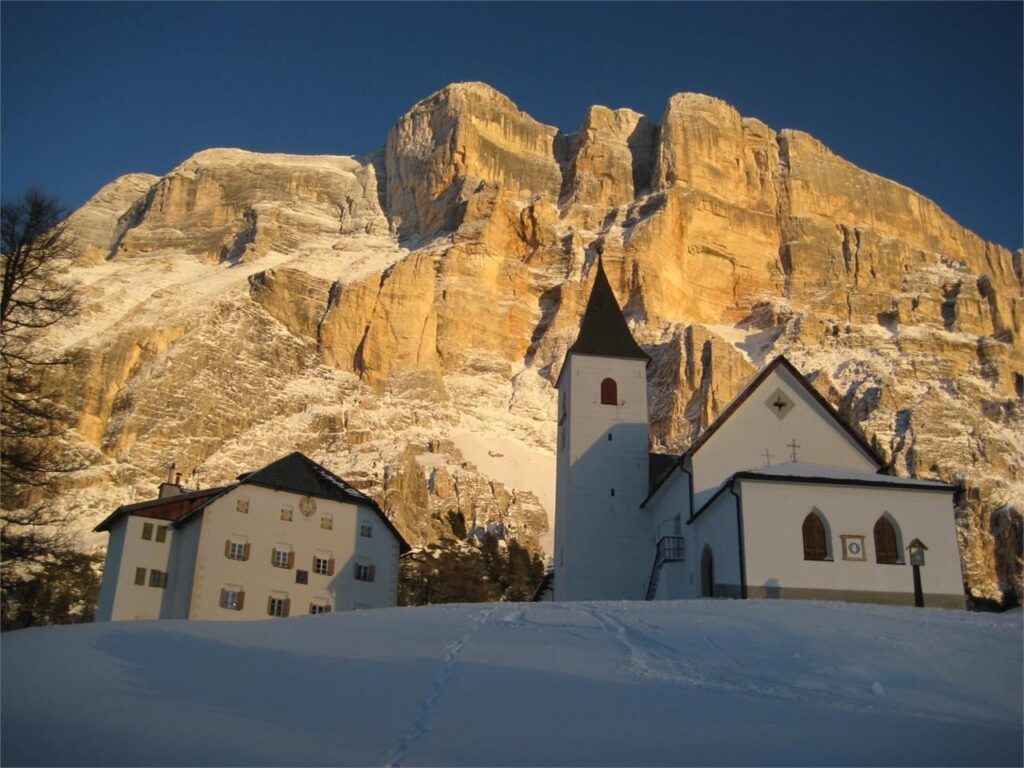
Now its time to strap on your planks for the long fast run back down – the initally blue and then red run is extremely wide and accommodating and you can really step on the gas here, with usually quiet skiing. After a few hundred metres theres a short funrun for the (adult) kids before flying down to the base station and doing it all over again!
Or jump back on the Praduc – make sure you head hard left as you come into the base area so that you can glide straight up to the gates of the lift! Now head back up to Utia Sponata on a chairlift for either a red or blue back to La Villa. Make sure you stay right as you near the bottom of the piste and hug the buildings to rejoin the link lift downwards back to the Piz La Ila gondola.
